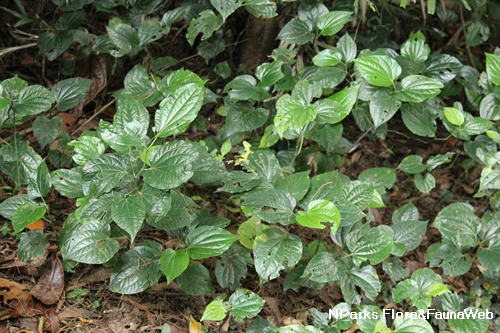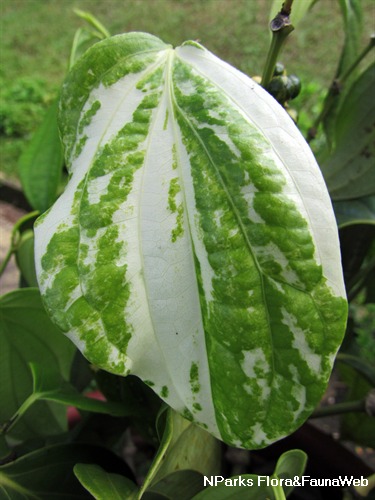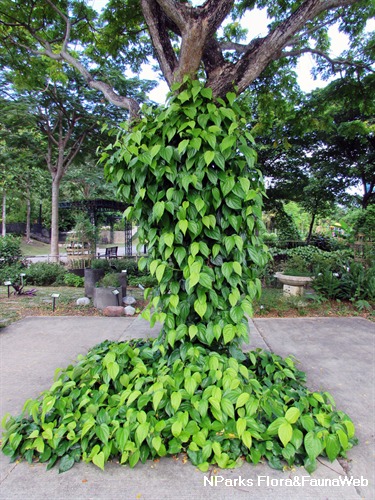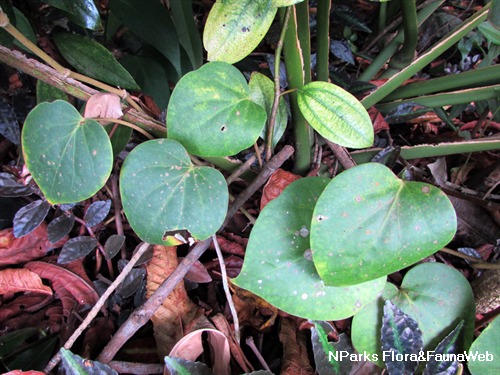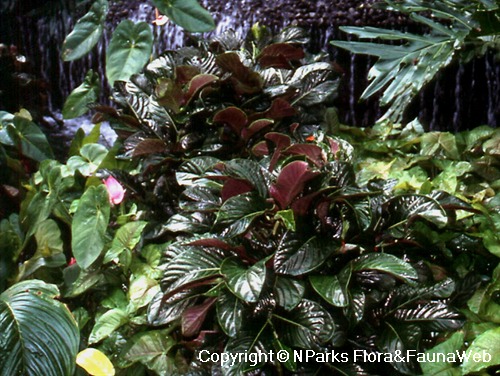
Back
Piper pseudolindenii C. DC.
| Family Name: | Piperaceae |
| Synonyms: | Piper pseudolindenii var. magnificum, Piper magnificum |
| Common Name: | Lacquered Pepper, Lacquered Pepper Tree, Peruvian Pepper |
Name
Classifications and Characteristics
| Plant Division | Angiosperms (Flowering Seed Plants) (Dicotyledon) |
|---|---|
| Plant Growth Form | Shrub |
| Lifespan (in Singapore) | Perennial |
| Mode of Nutrition | Autotrophic |
| Plant Shape | Shrubby |
| Maximum Height | 1.2 m to 1.8 m |
Biogeography
| Native Distribution | Belize, Costa Rica, El Salvador, Guatemala, Honduras, Mexico, Nicaragua, Panama |
|---|---|
| Preferred Climate Zone | Tropical |
Description and Ethnobotany
| Others - Plant Morphology | Woody shrub with stiff upright form. Stems square, ridged and corky. Leaves large, highly-glossy, dark green above and purple below, puckered appearance. Flowers light green, tubular, hanging from stems. Fruits are insignificant, pepper-like aggregated drupes, maturing to black.Related to the pepper plant (Piper) used in food. Ideal as specimen or container plant for its large, glistening and colourful foliage. Suitable for low-light conditions. Avoid exposing plant to full sun, as leaves get burnt easily. Although rather slow-growing, plant is easily transplanted. Propagate by stem cuttings and seeds.Likes moist, loamy soils with lots of organic matter. Feed with general purpose fertilizer once every 3 months in planting beds, or monthly for potted plants. |
|---|
Landscaping Features
| Desirable Plant Features | Ornamental Foliage |
|---|---|
| Landscape Uses | General, Container Planting, Interiorscape/ Indoor Plant |
| Thematic Landscaping | Naturalistic Garden |
Plant Care and Propagation
| Light Preference | Semi-Shade |
|---|---|
| Water Preference | Moderate Water |
| Plant Growth Rate | Slow |
| Rootzone Tolerance | Fertile Loamy Soils, Well-Drained Soils |
| Fertilizing | General-purpose fertilizer once every 3 months to planting bed, or once monthly to container plants. |
| Potential Problems | Plant gets sun-burnt easily if exposed to full sunlight or excessive light. |
| Propagation Method | Seed, Stem Cutting |
| Maintenance Requirements Remarks | Remove dead or straggly branches and leaves. |
Foliar
| Foliage Retention | Evergreen |
|---|---|
| Mature Foliage Colour(s) | Green, Purple |
| Mature Foliage Texture(s) | Smooth, Glossy / Shiny, Raised / Sunken Veins, Thick |
| Foliar Type | Simple / Unifoliate |
| Foliar Arrangement Along Stem | Alternate |
| Foliar Shape(s) | Non-Palm Foliage (Obovate) |
| Foliar Venation | Pinnate / Net |
| Foliar Margin | Entire |
| Foliar Apex - Tip | Acute |
| Foliar Base | Truncate / Square |
| Typical Foliar Area | Macrophyll ( 182.25cm2 - 1640.25 cm2 ) |
| Leaf Area Index (LAI) for Green Plot Ratio | 4.5 (Shrub & Groundcover - Dicot) |
Non - Foliar and Storage
| Stem Type & Modification | Woody |
|---|---|
| Root Type | Underground (Fibrous Root) |
Floral (Angiosperm)
| Flower Colour(s) | Green |
|---|---|
| Individual Flower Shape | Tubular |
| Flowering Habit | Polycarpic |
Fruit, Seed and Spore
| Mature Fruit Colour(s) | Black |
|---|---|
| Fruit Classification | Aggregate Fruit (Syncarp) |
| Fruit Type | Fleshy Fruit , Drupe |
Image Repository
Others
| Master ID | 1048 |
|---|---|
| Species ID | 2341 |
| Flora Disclaimer | The information in this website has been compiled from reliable sources, such as reference works on medicinal plants. It is not a substitute for medical advice or treatment and NParks does not purport to provide any medical advice. Readers should always consult his/her physician before using or consuming a plant for medicinal purposes. |


